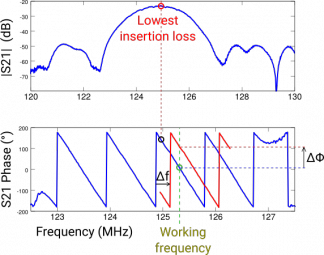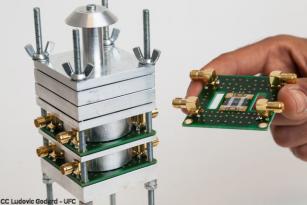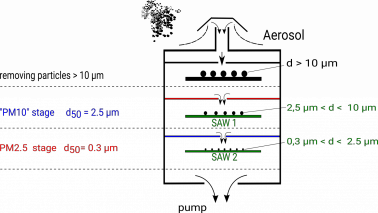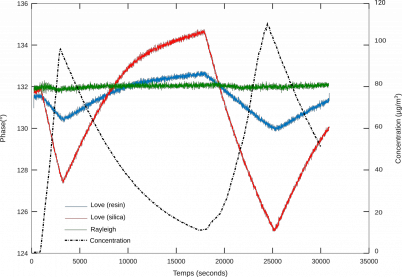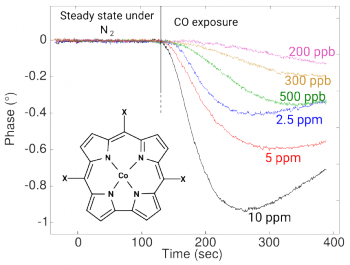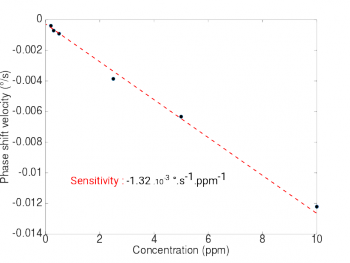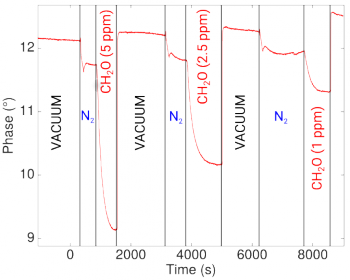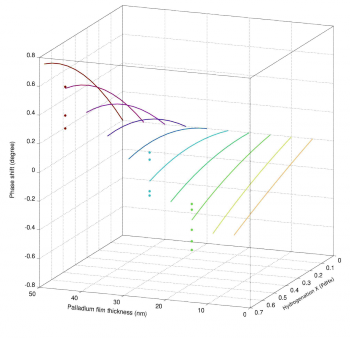SAW devices
Surface acoustic waves (SAWs) are well known for their high sensitivity to changes in the properties of the propagation medium. In our research team, we use SAW devices to produce sensors to measure environmental parameters. The purpose of our sensors is to interact with the external environment to measure their physico-chemical properties. For the manufacture of our sensors, we have therefore selected a delay configuration (Figure 1) with a large surface exposed to the environment.
Fig. 1: SAW delay line scheme.
The specific interaction with a single environmental parameter is carried out either by the functionalization of the sensitive zone of the sensor, or by a treatment upstream of the gas to be tested. The latter is preferred for the measurement of particles in the air while the former will typically be used for the selective detection of gases. In order to characterize the response of the sensor, we measure the variation of SAW phase velocity by means of dedicated electronics. The principle of phase measurement using an open loop strategy is shown in Figure 2.
Fig. 2: SAW delay line transfert function.
We select a frequency, called the working frequency, in the vicinity of the lowest insertion loss. Then we monitor the phase of the acoustic wave at this constant frequency. When the speed of the SAW phase is changed in response to environmental changes, the transfer function of the delay line shifts to low frequencies or low frequencies depending on the phenomenon at the root of the shift. This frequency shift ∆f is revealed by the corresponding phase shift ∆Ф measured at the working frequency.
Particles Sensors
Real-time measurement impactor
Air pollution and particulate pollution in particular are at the root of many health problems. As they can enter the lungs, particles smaller than 10 μm and 2.5 μm (PM10 and PM2.5 respectively) are particularly dangerous. Current measurement devices for monitoring air pollution are wide, expensive and require almost permanent maintenance. Developing small and inexpensive measurement systems is therefore a challenge for the future. The use of gravimetric surface acoustic wave (SAW) sensors offers many possibilities to solve this problem. In the framework of the P'AIR project (Atmospheric Intelligent Particle Research), our team was in charge of the development of a system for the measurement of microparticles in the air. The complete device, which was patented in 2016, can be used to build a dense network in a city to map particulate pollution. SAW sensors are naturally incapable of distinguishing the size and shape of the particles deposited on their surface. It is therefore necessary to use a system for separating these microparticles upstream of the sensors. For this purpose, an impaction filtration system, allowing the separation of particles according to their size, has been developed. The system and its structure are shown on figure 3 and 4 respectively. This allows a collection of non-rotating air flow (unlike cyclones). Air enters from above and at each stage, the particles with the greatest inertia are deviated from the flow path and are collected on an impaction plate which, in our case, consists of the SAW delay line. The smaller, lighter particles follow the airflow to the next step and so on.
Fig. 3: SAW devices integrated in a cascade impactor. Fig. 4: Dedicated impactor scheme.
Experimental achievement
Figure 6 shows the evolution of the sensor phase on the PM2.5 and PM10 stages when the system is exposed to particles from soldering iron. This experiment shows the ability of the system to measure the presence of particles on different stages. When the airflow stops, there is no more impaction of the microparticles and the sensor signal stabilizes.
Fig. 5: Comparison of acoustic modes gravimetric sensitivity. Fig. 6: SAW sensors phase to fine particles.
Gas sensors
Surface functionnalization.
A crucial step for the manufacturing of our gas sensors consists in the deposition of a sensitive layer on top of the SAW device. Layers displaying a specific nano-porosity allowing the trapping of small molecules can be deposited by dip- or spin-coating. These layers thickness varies from a fraction to more that ten times the acoustic wavelength. Synthetic molecules showing great gas trapping capabilities can be dispersed through an adapted solvent and deposited by spray-coating to obtain thin sensitive layers.
Fig. 7: Functionnalized SAW delay line.
Carbon monoxide sensor
Surface acoustic waves can be used to probe the properties of gas-sensitive materials for the manufacture of environmental sensors. Among these materials, cobalt corroles show great abilities for the selective trapping of carbon monoxide (CO). Associated with Love wave delay lines these compounds provide sensors able to measure CO concentrations down to a few hundreds ppb.
Fig. 8: Phase measurement during CO exposure. Fig. 9: CO sensor sensitivity.
Formaldehyde sensor
Other types of sensitive layers based on purely physical entrapment can be realized. SAW sensors have, for example, been functionalized by a material exhibiting a porosity specifically adapted to trapping formaldehyde (CH2O). A detection threshold of a few hundreds ppb has been demonstrated.
Fig. 10: Phase measurement during formaldehyde exposure.
Hydrogen sensor
The natural physicochemical properties of certain materials can also be used for the production of gas sensors. Delay lines using Rayleigh waves equipped with a palladium sensitive layer have shown capabilities for the detection of hydrogen under standard environmental conditions. The effect of the combination of yttrium and palladium as a detection layer on the sensor response is reported and its interest in improving the sensitivity of our sensor is finally discussed. Original studies such as X-ray diffraction analysis of the sensitive metal during hydrogenation have shown the correlation between the structural changes of the sensitive metal and the signal acquired simultaneously by our sensor.
Fig. 11: Hydrogenation of a palladium layer; comparison between phase measurement (dots) and calculation (lines).
These encouraging results pave the way for the development of functionnalized SAW sensor networks for multi-gas detection in indoor air as well as in constrained environments.


